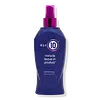What's inside
What's inside
 Key Ingredients
Key Ingredients

No key ingredients
 Benefits
Benefits

 Concerns
Concerns

 Ingredients Side-by-side
Ingredients Side-by-side

Water
Skin ConditioningPropylene Glycol
HumectantCetearyl Alcohol
EmollientCyclopentasiloxane
EmollientBehentrimonium Chloride
PreservativePanthenol
Skin ConditioningSilk Amino Acids
HumectantAloe Barbadensis Leaf Juice
Skin ConditioningCamellia Sinensis Leaf Extract
AntimicrobialHelianthus Annuus Seed Extract
Skin ConditioningQuaternium-80
Butylene Glycol
HumectantPhenoxyethanol
PreservativeMethylparaben
PreservativePropylparaben
PreservativeEthylparaben
PreservativeParfum
MaskingCitronellol
PerfumingHexyl Cinnamal
PerfumingLimonene
PerfumingLinalool
PerfumingWater, Propylene Glycol, Cetearyl Alcohol, Cyclopentasiloxane, Behentrimonium Chloride, Panthenol, Silk Amino Acids, Aloe Barbadensis Leaf Juice, Camellia Sinensis Leaf Extract, Helianthus Annuus Seed Extract, Quaternium-80, Butylene Glycol, Phenoxyethanol, Methylparaben, Propylparaben, Ethylparaben, Parfum, Citronellol, Hexyl Cinnamal, Limonene, Linalool
Water
Skin ConditioningIsopropyl Myristate
EmollientDimethicone
EmollientAmodimethicone
Triethanolamine
BufferingPhenoxyethanol
PreservativeParfum
MaskingCarbomer
Emulsion StabilisingPolyquaternium-4
Potato Starch Modified
Hydroxypropyl Guar
Emulsion StabilisingBehentrimonium Chloride
PreservativeCoco-Betaine
CleansingTrideceth-6
EmulsifyingIsopropyl Alcohol
SolventSodium Chloride
MaskingCetrimonium Chloride
AntimicrobialLinalool
PerfumingArgania Spinosa Kernel Oil
EmollientCocos Nucifera Oil
MaskingTheobroma Cacao Seed Butter
EmollientCoumarin
PerfumingLimonene
PerfumingGlycerin
HumectantCitronellol
PerfumingCocos Nucifera Fruit Extract
EmollientXanthan Gum
EmulsifyingPotassium Sorbate
PreservativeWater, Isopropyl Myristate, Dimethicone, Amodimethicone, Triethanolamine, Phenoxyethanol, Parfum, Carbomer, Polyquaternium-4, Potato Starch Modified, Hydroxypropyl Guar, Behentrimonium Chloride, Coco-Betaine, Trideceth-6, Isopropyl Alcohol, Sodium Chloride, Cetrimonium Chloride, Linalool, Argania Spinosa Kernel Oil, Cocos Nucifera Oil, Theobroma Cacao Seed Butter, Coumarin, Limonene, Glycerin, Citronellol, Cocos Nucifera Fruit Extract, Xanthan Gum, Potassium Sorbate
 Reviews
Reviews

Ingredients Explained
These ingredients are found in both products.
Ingredients higher up in an ingredient list are typically present in a larger amount.
This ingredient is a preservative and often used for it's anti-static properties. You'll most likely see this ingredient in hair conditioners.
It does not cause irritation or sensitization in leave-on products at 1-5%.
Citronellol is used to add fragrance/parfum to a product. It is often derived from plants such as roses. In fact, it can be found in many essential oils including geranium, lavender, neroli, and more. The scent of Citronellol is often described as "fresh, grassy, and citrus-like".
Since the Citronellol molecule is already unstable, Citronellol becomes irritating on the skin when exposed to air.
Citronellol is a modified terpene. Terpenes are unsaturated hydrocarbons found in plants. They make up the primary part of essential oils.
Citronellol is not able to be absorbed into deeper layers of the skin. It has low permeability,
Citronellol is also a natural insect repellent.
Learn more about CitronellolLimonene is a fragrance that adds scent and taste to a formulation.
It's found in the peel oil of citrus fruits and other plants such as lavender and eucalyptus. The scent of limonene is generally described as "sweet citrus".
Limonene acts as an antioxidant, meaning it helps neutralize free radicals.
When exposed to air, oxidized limonene may sensitize the skin. Because of this, limonene is often avoided by people with sensitive skin.
The term 'fragrance' is not regulated in many countries. In many cases, it is up to the brand to define this term. For instance, many brands choose to label themselves as "fragrance-free" because they are not using synthetic fragrances. However, their products may still contain ingredients such as essential oils that are considered a fragrance.
Learn more about LimoneneLinalool is a fragrance and helps add scent to products. It's derived from common plants such as cinnamon, mint, citrus, and lavender.
Like Limonene, this ingredient oxidizes when exposed to air. Oxidized linalool can cause allergies and skin sensitivity.
This ingredient has a scent that is floral, spicy tropical, and citrus-like.
Learn more about LinaloolParfum is a catch-all term for an ingredient or more that is used to give a scent to products.
Also called "fragrance", this ingredient can be a blend of hundreds of chemicals or plant oils. This means every product with "fragrance" or "parfum" in the ingredients list is a different mixture.
For instance, Habanolide is a proprietary trade name for a specific aroma chemical. When used as a fragrance ingredient in cosmetics, most aroma chemicals fall under the broad labeling category of “FRAGRANCE” or “PARFUM” according to EU and US regulations.
The term 'parfum' or 'fragrance' is not regulated in many countries. In many cases, it is up to the brand to define this term.
For instance, many brands choose to label themselves as "fragrance-free" because they are not using synthetic fragrances. However, their products may still contain ingredients such as essential oils that are considered a fragrance by INCI standards.
One example is Calendula flower extract. Calendula is an essential oil that still imparts a scent or 'fragrance'.
Depending on the blend, the ingredients in the mixture can cause allergies and sensitivities on the skin. Some ingredients that are known EU allergens include linalool and citronellol.
Parfum can also be used to mask or cover an unpleasant scent.
The bottom line is: not all fragrances/parfum/ingredients are created equally. If you are worried about fragrances, we recommend taking a closer look at an ingredient. And of course, we always recommend speaking with a professional.
Learn more about ParfumPhenoxyethanol is a preservative that has germicide, antimicrobial, and aromatic properties. Studies show that phenoxyethanol can prevent microbial growth. By itself, it has a scent that is similar to that of a rose.
It's often used in formulations along with Caprylyl Glycol to preserve the shelf life of products.
Water. It's the most common cosmetic ingredient of all. You'll usually see it at the top of ingredient lists, meaning that it makes up the largest part of the product.
So why is it so popular? Water most often acts as a solvent - this means that it helps dissolve other ingredients into the formulation.
You'll also recognize water as that liquid we all need to stay alive. If you see this, drink a glass of water. Stay hydrated!
Learn more about Water